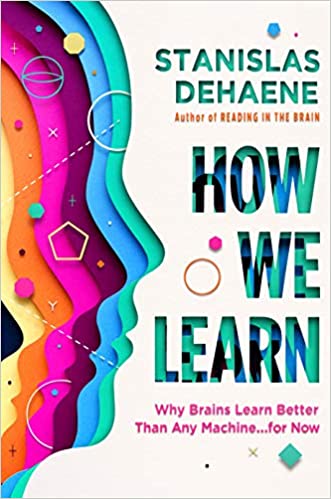You have /5 articles left.
Sign up for a free account or log in.
 How We Learn: Why Brains Learn Better Than Any Machine … for Now by Stanislas Dehaene
How We Learn: Why Brains Learn Better Than Any Machine … for Now by Stanislas Dehaene
Published in January 2020
Thought experiment: You get a clean-sheet opportunity to design a university. How might that university be designed to align with what we've learned about learning?
What would a learning science-informed institution look like?
Another way to ask this question is to start with how our universities are designed today and ask which elements support or conflict with the research on learning.
It is from that institutional design perspective that I read How We Learn, by Stanislas Dehaene (a French cognitive neuroscientist).
Whenever I read the learning science literature, I'm always looking for clues of how to translate the research findings on learning into insights on institutional change. This translational thinking is challenging, as the scale on which learning scientists and university leaders think is different.
The learning scientist studies individual learners. Academic leaders must think about how organizational structures, budgets, programs, initiatives, staffing and institutional priorities impact learners.
There seems to be very little crosstalk between learning scientists and academic leaders. The two groups speak different languages. They have different units of analysis.
Fortunately, How We Learn does provide a usable learning science framework that can be scaled up to the level of institutional change.
How We Learn is divided into three sections. Each section is informative, but it is the third part of the book that will be most useful from an institutional perspective.
The first part of the book provides the reader with an understanding of how learning works (Part One: What Is Learning). The second section is all about the biological underpinnings of human learning (Part Two: How Our Brains Learn).
It is Part Three: The Four Pillars of Learning in which we can perhaps build a learning science-based framework for institutional change.
The four pillars of learning that Dehaene identifies are:
- Attention
- Active engagement
- Error feedback
- Consolidation
Incorporating these foundational elements of learning into the teaching strategies of individual instructors seems like an attainable goal. Indeed, we have nearly six decades of experience with educational developers trained in the scholarship of teaching and learning, working with faculty to advance their teaching. (The first center for teaching and learning, Michigan's Center for Research on Learning and Teaching, was founded in 1962.)
CTLs have taken on the twin missions of collaborating with faculty and informing institutional change throughout their history. However, there is a question of the degree to which the research on learning has impacted the structural designs, stated missions and spending priorities of colleges and universities.
If a university wanted to support a professor in promoting the four pillars of learning, what would this look like on the ground?
We know that despite the research, institutions continue to build new lecture classrooms that feature tiers of fixed seating. That classroom design violates the principle of active engagement, in which students and instructors co-create knowledge through collaboration, hands-on project work and constant coaching.
A classroom designed around the ideas of active engagement would likely feature flat floors, movable furniture, multiple screens and plenty of whiteboards on which student teams might collaborate.
Similarly, it is still rare within traditional institutions to rethink the structure of undergraduate grading. The research on error feedback is clear that final grades, the high-stakes assessments in which grades are compromised, can easily work against the goal of student learning if not carefully managed.
The organizational structure in which assessment occurs pushes students (and professors) to view tests as evaluation methods rather than learning tools. Opportunities for frequent error feedback are lost if the emphasis is on the grade instead of the learning.
Similar examples in which an institutional perspective is applied to the pillars of learning could be found for both attention and consolidation. We can ask questions about the attention-dividing nature of a curricular design that requires students to navigate numerous disciplines in their first two years of college instead of focusing more deeply on an integrated set of questions and challenges.
And to the extent that schedules for midterms and finals erode students' sleep in predictable patterns, we can ask why we have set up a structure that works against the consolidation of information in the service of completing high-stakes examinations.
Moving across levels of individual learning, classroom pedagogical practices and institutional design is a task. We tend to see the structures in which learning occurs as unchanging. Or at least out of the control of the individuals, the faculty and students, who are trying to teach and learn in an environment that they did not design.
We should read books like How We Learn with an understanding that we have the agency to redesign the environment in which teaching and learning occur.
Creating a new university around the research on learning science may be unattainable. (Unless you work at Minerva University.)
Still, all of us can work to evolve the institutions that we have inherited toward better alignment with the research on how we learn.
What are you reading?




